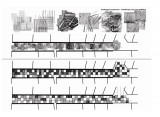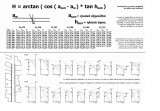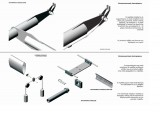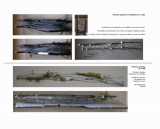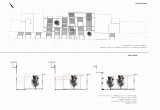Supervisor:
Urban Design and Planning
Technology
2006
In the present project a bioclimatic intervention in a central region of Heraklion of Crete is attempted. The region of intervention includes the pedestrian zones of Daidalou, Korai and the square at the pedestrian zone of Korai. In the region are located mainly commercial shops (Daidalou) and restaurants and cafeterias (Korai, square).The orientation of the two streets is North-eastern – South-western. The heights of the adjacent buildings vary, while the width of the two streets oscillates from 5 to 6 metres.
Even though the width of streets is not big, because of the orientation, the region is exposed to sun during the day. As a result there is a lack of thermal comfort and reflections are caused at the windows of shops. The problem is intensified in the summertime. For the increase of the rate of comfort of users, a light metal construction is proposed, which regulates the percentage of exposure to sun of the region each time, without preventing the movement of the air.
In the first phase of our study the centre of Heraklion is analysed from photographs and maps. The region of intervention is located and sections are designed, so that the shade that the existing buildings create is calculated from 9:00 – 17:00 for 21/03, 21/06, 21/07, 21/08, 21/09 and 21/12. On these sections the beam of helium is designed for each hour. Then, the suitable places that shades can be placed are tried.
At the same time, we study the texture of the shade that various materials can provide. Models of shades are built, which give different shades and possible combinations are made. Then, linings are drawn at the region so that a unified network for the places of the shades is created. According to these linings models are made, where various shades are placed. The density of the shades differs depending on the time each region is exposed to sun. Dense shades are placed at the parts of the street which is exposed to sun for a long time. A specific construction of simulation is made according to the geographic length and width of the region, which was used in a laboratory which simulates the sun in the university. Models were photographed and the shades were imprinted from 10:00 – 17:00 for the day of the biggest sunlight exposure (21 June).
From the above we are led to the creation of a metal construction which will be constituted by self-adjusting shades, of different density and bent. The shelters will be constituted by blinds of aluminium, 15cm width and 3m length, which will be turned proportionally. The blinds are supported in wipe rope, which is supported in metal joists of circular cross-section. For distances up to 6 metres (pedestrian zones) the cross-section of joists is 6 cm, while for 10 – 15 metres (square) 16cm. The metal joists are applied to the facades of adjacent buildings. In certain blinds lamps will be incorporated, which will light the region during the evening hours.
The shades that are proposed are separated in two levels. In the lower level, in the entire region, the metal joists are perpendicular to the facades of the buildings, while the blinds parallel to them. However, the shades in the higher level at the pedestrian zones are differentiated, where the joists are placed diagonal, creating acute and obtuse corners with the facades of the buildings. Thus, the texture of the shade is differentiated depending on the use (street – square).
Finally, a research was conducted for the possible replacement of the blinds which are proposed, with other alternative materials. They can, therefore, be adapted blinds inflatable, perforated, glassy, colourful, photovoltaic etc, while their mechanism of rotation can also become automated via special photosensor.

